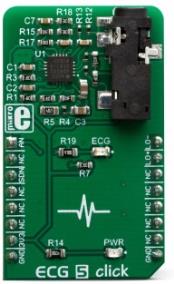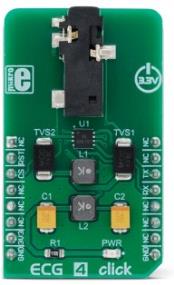|
|
| |
|
 | Search: |
|
|
 |

|
|
ECG 5 click can be used for the development of ECG and Heart-Rate (HR) applications. The Click board™ features the AD8232, an integrated bio-signal front end. This IC has many features necessary for providing accurate ECG measurements, including very high common-mode rejection ratio, high gain with DC blocking capability, adjustable high-pass and low-pass filters, integrated right leg drive (RLD), etc. Electrodes presence detection pin helps to reduce the overall power consumption, as it can be used to set the standby mode of the host MCU. The fully conditioned bio-signal is available at the analog output to be sampled by an external A/D converter.
ECG 5 click is supported by a mikroSDK compliant library, which includes functions that simplify software development. This Click board™ comes as a fully tested product, ready to be used on a system equipped with the mikroBUS™ socket.
|
|
|
|
|
 |

|
|
This is an ECG (or EKG) machine on a click board. It measures the electrical activity of a beating heart through electrodes taped to the skin. The board requires little setup, and the final measurement results can be displayed as an electrocardiogram using a free Windows app.
With the ECG click bundle (click + cable + electrodes) you will be able to prototype your own health-tracking and fitness devices, quantified-self wearable or you can just make an LED blink in sync with your heart. |
|
|
|
 |

|
|
Track the patterns of your beating heart with ECG 2 click. ECG 2 click contains ADS1194 16-bit delta-sigma analog-to-digital converters from Texas Instruments, a built-in programmable gain amplifier (PGA), an internal reference, and an onboard oscillator. |
|
|
|
 |

|
|
ECG 3 click is a complete solution for the development of ECG applications, which utilizes a specialized clinical-grade biopotential analog front-end (AFE) IC. ECG click uses the MAX30003 IC, an ultra-low power, single channel, integrated biopotential AFE, which features a wide range of options, making it a universal solution for many different types of ECG applications. ECG 3 click is an ideal solution for the development of heart rate monitoring applications, fitness applications, for the ECG bio-authentication, and similar applications.
It comes in the package which also includes the mikroSDK™ software and a library with all the functions. The Click board™ comes as a fully tested and approved prototype, making it a reliable device ready to use on the development board.
|
|
|
|
 |

|
|
ECG 4 Click is a complete solution for the development of ECG and Heart-Rate (HR) applications, based on the BMD101, a specialized bio-signal sensing System-on-Chip (SoC). ECG 4 click offers a reliable and accurate ECG and heart-rate monitoring, by sending processed bio-data over the UART interface. Its interface offers great flexibility and thus, very simple integration into any development environment. Besides the highly specialized bio-sensing SoC, ECG 4 click is equipped with the 3.5mm electrodes connector, as well as with ESD protection diodes, making it ready to be used out of the box.
ECG 4 Click is supported by a mikroSDK compliant library, which includes functions that simplify software development. This Click board™ comes as a fully tested product, ready to be used on a system equipped with the mikroBUS™ socket.
|
|
|
|
 |

|
|
Disposable adhesive electrode pads. |
|
|
|
 |
|
|
 |

|
|
ECG/EMS/GSR cable is a durable 1.5 m long insulated copper cable, with a small 3.5 mm jack on one end and the electrode holders on the other end. The cable is used to securely connect the electrodes to the appropriate click board™. The two electrode holders consist of a metal piece that has a dent in the middle, that perfectly fits the rivets on the electrodes. The contact with the measurement click board™ remains good and secure while mounting the electrodes on the cable is simple and easy.
Note: The cable without probes is not meant to be used as such, the cable is used to connect the appropriate electrodes, depending on the required type: it can be used with either ECG, EMS or GSR type of probes. |
|
|
|
 |
|
|

